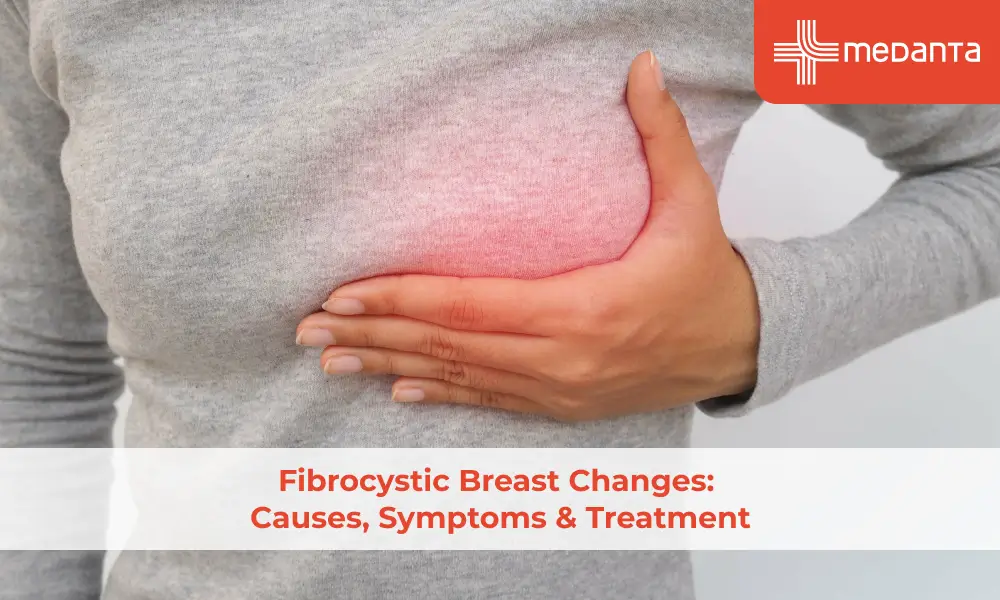Fibrocystic Breast Changes: Causes, Symptoms & Treatment

TABLE OF CONTENTS
The tissue that makes up fibrocystic breasts has a bumpy or rope-like appearance. Doctors refer to this breast tissue as glandular or nodular breast tissue.
Having fibrocystic breasts or going through fibrocystic breast alterations is not unusual. In reality, because having fibrocystic breasts is not a disease, medical practitioners no longer use the phrase "fibrocystic breast illness" and now instead refer to "fibrocystic breasts" or "fibrocystic breast alterations." It is typical for breast alterations to vary with the menstrual cycle and to feel like ropes.
Not all fibrocystic breast alterations result in symptoms. Breast soreness, tenderness, and lumpiness are common complaints, particularly in the upper, and outer portion of the breasts. Before menstruation, breast symptoms are often at their worst and become better in later life.
Usually, simple self-care techniques can ease the discomfort brought on by fibrocystic breasts.
Alarming factors:
The hormones produced by the ovaries cause changes in your breast tissue. The way your body reacts to these hormones can vary more noticeably if you have fibrocystic breasts. This can cause swelling as well as sensitive or painful breast lumps.
The most frequent symptoms occur right before or during your menstruation. Cysts as well as swelling of your breast lobules, the milk-producing glands, can cause lumps to form in your breasts. A surplus of fibrous tissue may also cause your breast to feel thickened and lumpy.
Although having fibrocystic breast disease does not affect your chance of developing cancer, the changes to your breasts may make it more challenging for you or your doctor to spot possibly malignant lumps during breast examinations and mammograms.
You must get familiar with the usual appearance and sensation of your breasts so that you can recognise alterations or anomalies.
Symptoms:
There are several different symptoms associated with fibrocystic breast alterations, including:
Breast sensitivity or soreness may worsen right before menstruation.
The abrupt emergence or disappearance of breast benign tumors that may be seen or felt.
Bulges in the breast that are lumpy and move freely, frequently under the arm. These are frequently unnoticeable (painless) and are found accidentally or when doing breast self-exams.
Beyond age 30yrs, symptoms may get worse, and after age 35yrs, they may get worse again.
Diagnosis:
The most frequent method for diagnosing fibrocystic alterations is by symptoms, like breast lumps, swelling, soreness, or discomfort. As your menstrual cycle progresses, these symptoms may fluctuate (such as the lumps enlarging or contracting). They often get worse right before your period. You could sometimes see some nipple discharge.
Breast ultrasounds are frequently performed when there is a suspicion that a lump may be cancerous to determine if it is solid or fluid-filled (i.e., whether it is a cyst). Cysts come in a variety of forms:
Simple cysts are fully liquid-filled. Simple cysts are nothing to worry about.
Similar to a simple cyst, a complex cyst features what seems to be "debris" floating in the fluid. Even though complicated cysts are extremely unlikely to be cancer, a doctor may occasionally recommend a follow-up check or a treatment to drain the fluid using a tiny, hollow needle to be safe.
A solid component or thick outer walls are characteristics of a complicated cystic and solid mass. A biopsy is typically required to determine if these results are malignant since they are more likely to be cancerous.
Treatment:
There is no need for therapy if you don't have any symptoms or if they are minor for fibrocystic breasts. Treatment may be necessary if you have fibrocystic breasts or if you have excruciating discomfort or huge, painful cysts.
Breast cysts can be treated in the following ways:
Fine-needle aspiration. The fluid from the cyst is drained by your doctor using a hair-thin needle. By effectively shrinking the cyst and confirming that it is a breast cyst, the fluid is removed, reducing the discomfort it causes.
Surgical excision. Rarely, surgery may be required to eradicate a persistent cyst-like mass that is bothersome to your provider during a clinical exam or that doesn't go away despite repeated aspirations and close monitoring.
Painkillers: Nonsteroidal anti-inflammatory medicines (NSAIDs), such as ibuprofen (Advil, Motrin IB, etc.), as well as over-the-counter and prescription painkillers like acetaminophen (Tylenol, among others) and aspirin are all effective ways to reduce pain.
Conclusion:
Breast alterations due to fibrocystic disease are benign and pose no risk to the patient. However, it is crucial to assess any development in the breasts very away to see if it is malignant. Some fibrocystic breast alterations in women put them at increased risk for developing cancer. If that is the case, your doctor can guide you and keep an eye on you.
Any woman who notices new growths in her breasts should see a doctor as soon as possible to have them examined.
What Are Fibrocystic Breasts?
The tissue that makes up fibrocystic breasts has a bumpy or rope-like appearance. Doctors refer to this breast tissue as glandular or nodular breast tissue.
Having fibrocystic breasts or going through fibrocystic breast alterations is not unusual. In reality, because having fibrocystic breasts is not a disease, medical practitioners no longer use the phrase "fibrocystic breast illness" and now instead refer to "fibrocystic breasts" or "fibrocystic breast alterations." It is typical for breast alterations to vary with the menstrual cycle and to feel like ropes.
Not all fibrocystic breast alterations result in symptoms. Breast soreness, tenderness, and lumpiness are common complaints, particularly in the upper, and outer portion of the breasts. Before menstruation, breast symptoms are often at their worst and become better in later life.
Usually, simple self-care techniques can ease the discomfort brought on by fibrocystic breasts.
Alarming factors:
The hormones produced by the ovaries cause changes in your breast tissue. The way your body reacts to these hormones can vary more noticeably if you have fibrocystic breasts. This can cause swelling as well as sensitive or painful breast lumps.
The most frequent symptoms occur right before or during your menstruation. Cysts as well as swelling of your breast lobules, the milk-producing glands, can cause lumps to form in your breasts. A surplus of fibrous tissue may also cause your breast to feel thickened and lumpy.
Although having fibrocystic breast disease does not affect your chance of developing cancer, the changes to your breasts may make it more challenging for you or your doctor to spot possibly malignant lumps during breast examinations and mammograms.
You must get familiar with the usual appearance and sensation of your breasts so that you can recognise alterations or anomalies.
Common Symptoms of Fibrocystic Breasts
There are several different symptoms associated with fibrocystic breast alterations, including:
Breast sensitivity or soreness may worsen right before menstruation.
The abrupt emergence or disappearance of breast benign tumors that may be seen or felt.
Bulges in the breast that are lumpy and move freely, frequently under the arm. These are frequently unnoticeable (painless) and are found accidentally or when doing breast self-exams.
Beyond age 30yrs, symptoms may get worse, and after age 35yrs, they may get worse again.
How Fibrocystic Breasts Are Diagnosed
The most frequent method for diagnosing fibrocystic alterations is by symptoms, like breast lumps, swelling, soreness, or discomfort. As your menstrual cycle progresses, these symptoms may fluctuate (such as the lumps enlarging or contracting). They often get worse right before your period. You could sometimes see some nipple discharge.
Breast ultrasounds are frequently performed when there is a suspicion that a lump may be cancerous to determine if it is solid or fluid-filled (i.e., whether it is a cyst). Cysts come in a variety of forms:
Simple cysts are fully liquid-filled. Simple cysts are nothing to worry about.
Similar to a simple cyst, a complex cyst features what seems to be "debris" floating in the fluid. Even though complicated cysts are extremely unlikely to be cancer, a doctor may occasionally recommend a follow-up check or a treatment to drain the fluid using a tiny, hollow needle to be safe.
A solid component or thick outer walls are characteristics of a complicated cystic and solid mass. A biopsy is typically required to determine if these results are malignant since they are more likely to be cancerous.
Treatment Options for Fibrocystic Breast Pain or Cysts
There is no need for therapy if you don't have any symptoms or if they are minor for fibrocystic breasts. Treatment may be necessary if you have fibrocystic breasts or if you have excruciating discomfort or huge, painful cysts.
Breast cysts can be treated in the following ways:
Fine-needle aspiration. The fluid from the cyst is drained by your doctor using a hair-thin needle. By effectively shrinking the cyst and confirming that it is a breast cyst, the fluid is removed, reducing the discomfort it causes.
Surgical excision. Rarely, surgery may be required to eradicate a persistent cyst-like mass that is bothersome to your provider during a clinical exam or that doesn't go away despite repeated aspirations and close monitoring.
Painkillers: Nonsteroidal anti-inflammatory medicines (NSAIDs), such as ibuprofen (Advil, Motrin IB, etc.), as well as over-the-counter and prescription painkillers like acetaminophen (Tylenol, among others) and aspirin are all effective ways to reduce pain.
Conclusion:
Breast alterations due to fibrocystic disease are benign and pose no risk to the patient. However, it is crucial to assess any development in the breasts very away to see if it is malignant. Some fibrocystic breast alterations in women put them at increased risk for developing cancer. If that is the case, your doctor can guide you and keep an eye on you.
Any woman who notices new growths in her breasts should see a doctor as soon as possible to have them examined.






